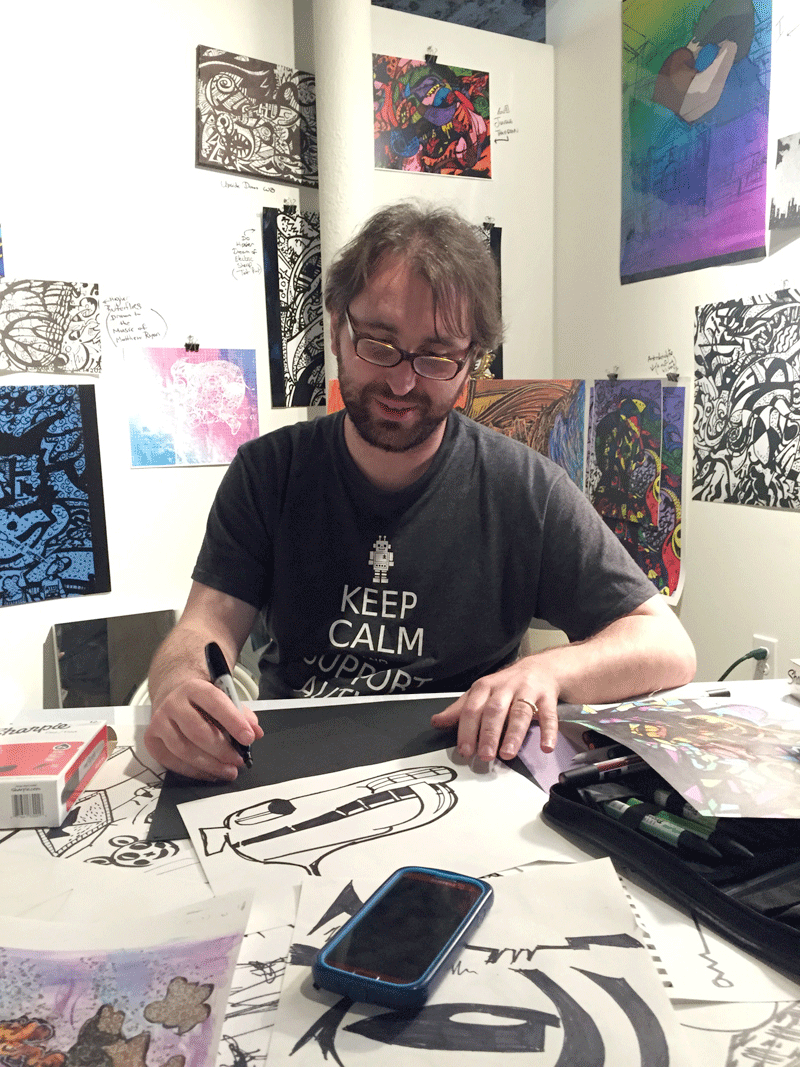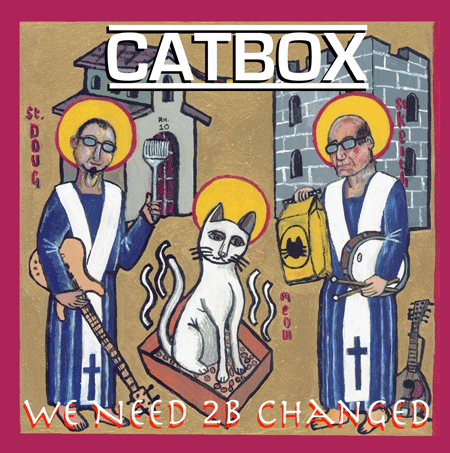Thick bold lines contrast with thin details while swoops and zigzags intersect with each other, creating hundreds of organic and geometric shapes that artist Frank Lewis Allen often transforms into recognizable objects such as animals, crazy eyes or ocean waves. It is the density of line on paper that sets Allen’s work apart from most. His work controls the viewer’s eye, pulling it up, down, across and back over the page. The longer one looks, the more one sees: thick black shards come together to create a bird’s wing; simple repeating patterns add another layer of interest. Step up to one of his works and it will hold you firmly in place as your mind dives in trying to interpret and comprehend the thoughts behind the drawing. One can’t help but wonder about the artist’s process.
Without fear, Allen attacks a blank page. With a black Sharpie in hand, his fingers guide the pen in powerful, curls and dashes. After putting down a few long, looping lines, the foundation is set and Allen takes but a few seconds to study the start of a new drawing, then quickly sets in filling shapes with detail and adding more long lines. His pen is swift, and he works fast, trying not to let logical thought get in his way.
“The piece is usually in sections,” he says. “I just keep doing different bits and pieces and it starts to look like something. A lot of times I go on feeling like it’s rubbish but then I carry on a bit and it sort of works out.”
It has only been four years that the artist has been able to put his thoughts on paper. Before that, debilitating anxiety kept him from making any attempts at drawing. Now you could say it has become a bit of an obsession.
Anxiety and obsessive behaviors are typical emotional hurdles that many on the autism spectrum must deal with on a daily basis. Allen is no different. Being an aspie (one who suffers from Asperger’s Syndrome, which is believed to be part of the autism spectrum) he gives a great deal of credit to a brain he describes as being “so full of ideas it feels like static.
“If I find an outlet to put something down, stuff will just come out,” he adds. “Stuff is there; I just can’t see it in my brain. It has to come out to exist.”
His first drawing was made as a result of an accident that left him temporarily disabled. Prior to the accident Allen had been fixated on exercise which he took part in for over two hours each day. One day he hurt his back, crushed a disk and ended up bedridden, unable to keep up his daily routine. While being visited by a supportive friend, the two listened to music and Allen picked up a pen.
“I just did some scribbling and it was art. It sort of gave me confidence. Now I’ve sort of blown it out of the water.”
His anxiety toward drawing has eased. By letting his mind take over, Allen’s drawings are directed by his stream of consciousness.
“You can draw whatever. It doesn’t feel like you’re responsible,” he says.
During a recent solo show at Jennifer Ford Art, Allen was set up in his own drawing den. The space was filled with music, video and lights, and walls were plastered with pieces of his work. What might be over the top for many people served as the perfect energy that fed the artist’s brain. External stimulus keeps Allen from thinking too much. It allows him to focus on a drawing while keeping his anxiety at bay.
With about 300 pieces in his archive, Allen’s stream of ideas seems limitless. (During this interview, Allen drew continuously, stopping only to pull up a few photos on his phone.) Able to pump out 13 drawings in one night, Allen is known for his speed. Drawing marathons like these have recently filled his nights as he prepares for a few upcoming group shows at Wunderkammer Company.
Allen is also known to experiment; one painting was rendered in sparkling nail polish while other drawings cover objects such as shoes and even a guitar. He also mixed things up when he tried applying gold ink to black paper.
“It seemed to work really well.” Not so for paint. “Watercolor and I didn’t get on,” said Allen.
He may not have connected with watercolor, but his work connects with people. He has found success in Fort Wayne and is represented by both Jennifer Ford Art and Artworks the Galleria. Thirteen of his pieces hang in the halls of Indiana Tech.
“There are two massive pieces and 11 smaller pieces,” he says. “All black and white with a bit of university colors added.”
Connecting with people is something that those on the autism spectrum often find difficult. Allen’s art has given him a source of connection that helps him reach out to others and to make new friendships. His art is a conversation starter; it makes people ask questions.
“I am comfortable talking to people one on one, but in a group I am quickly overwhelmed,” he says.
During his last gallery opening there were “lots of people sitting around my drawing table, drawing together,” he said. Allen, feeling overwhelmed, said he couldn’t find his flow and commented, “Everyone else was doing what I always do. They were all relaxed, but I couldn’t do it.”
Struggle is nothing new to Allen but when he hears talk about finding a cure for autism, he feels hurt by the common line of thinking.
“It’s like saying I’m invalid. It’s like saying my life isn’t a good one, which is crazy. I think people think they see their children having a hard time and they wish their children could have been born without autism. It’s more about the world accepting people.”
Allen’s work is a vehicle that helps others understand and accept that every person on the spectrum has value. It opens doors to connect people who may have never had the chance to speak to one another.
Through curiosity and awe, Allen’s unique pieces hold strangers together, standing side by side as they contemplate meaning of his work and discover lines and shapes that cross the page.
Allen is a man who happened to unveil a hidden talent within him and with that has unleashed the power of art.



